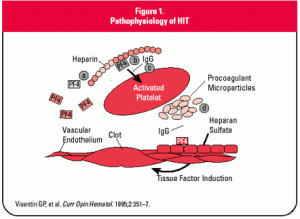The risk of heparin-associated bleeding increases with the dose
The American College of Cardiology recommends a heparin bolus of 60 to 70 U/kg (maximum dose, 5,000 U) and the infusion of 12 to 15 U/kg/h (maximum dose, 1,000 U per hour) for unstable angina and non-ST-segment elevation myocardial infarction (MI), and somewhat lower dosing (60 U/kg bolus [maximum dose, 4,000 U], and 12 U/kg infusion (maximum dose, 1,000 U per hour) in patients receiving recombinant tissue plasminogen activator (rt-PA) [alteplase] for acute ST-segment elevation MI. In patients undergoing percutaneous coronary interventions, heparin is administered in conjunction with glycoprotein IIb/IIIa inhibitors as a bolus of 70 U/kg, with additional boluses administered to keep the activated clotting time (ACT) at > 200 s. 
The risk of heparin-associated bleeding increases with the dose, and with thrombolytic therapy or glycoprotein IIb/IIIa inhibitor therapy. The risk of bleeding is also increased if the patient has recently undergone surgery, trauma, or invasive procedures, or has concomitant hemostatic defects. A relationship has been reported between the dose of heparin administered and both its efficacy and safety. Therefore, the dose of heparin must be adjusted, usually by the measurement of the aPTT, or, when very high doses are given, by ACT. These tests are sensitive mainly to the AT effects of heparin.
The anticoagulant effect of heparin is monitored by the aPTT when usual therapeutic doses are used and by the ACT when higher doses are used in association with percutaneous coronary interventions and cardiopulmonary bypass surgery. In the 1970s, an aPTT in the range of 1.5 to 2.5 times the control value was shown to be associated with a reduced risk for recurrent thromboembolism. Thereafter, a therapeutic aPTT range of 1.5 to 2.5 times the control value gained wide clinical acceptance.
However, the reagents and instruments used to determine the aPTT have changed in the past 25 years. Thus, there are now > 300 different laboratory methods in current use, and as a result there is a wide variation in responsiveness to an anticoagulant among different laboratories. This variability is due to differences among thromboplastin reagents and coagulometer instruments. The magnitude of this variability is highlighted by the observation that at plasma heparin concentrations of 0.3 IU/mL (by factor Xa inhibition) the mean aPTT results range from 48 to 108 s, depending on the laboratory method employed. At therapeutic heparin levels (ie, 0.3 to 0.7 anti-factor Xa units), modern thromboplastin reagents produce aPTT ratios that range from 1.6 to 2.7 to 3.7 to 6.2 times the control value (Table 3). It is clear, therefore, that the use of a standard aPTT therapeutic range of 1.5 to 2.5 for all reagents and methods of clot detection leads to the systematic administration of subtherapeutic doses of heparin.
Despite these shortcomings, the aPTT is the most common method used for monitoring its anticoagulant response.
Subscribe on our Instagram Canadian Health Care Mall.






